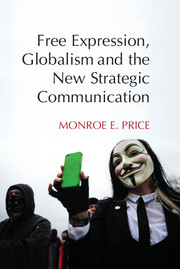Book contents
- Frontmatter
- Contents
- Acknowledgments
- 1 Moving the Needle, Filling the Streets
- 2 Strategic Communication and the Foundations of Free Expression
- 3 Narratives of Legitimacy
- 4 Strategies of the Diagnostic
- 5 Asymmetries and Strategic Communication
- 6 Strategies of System Architecture
- 7 Soft Power, Soft War
- 8 Religions and Strategic Communication
- 9 Regulating NGOs in the Market for Loyalties
- 10 Strategic Platforms
- 11 Strategic Communication and Satellite Channels
- 12 Strategies of Closure, Markers of Anxiety
- Bibliography
- Index
- References
6 - Strategies of System Architecture
Published online by Cambridge University Press: 18 December 2014
- Frontmatter
- Contents
- Acknowledgments
- 1 Moving the Needle, Filling the Streets
- 2 Strategic Communication and the Foundations of Free Expression
- 3 Narratives of Legitimacy
- 4 Strategies of the Diagnostic
- 5 Asymmetries and Strategic Communication
- 6 Strategies of System Architecture
- 7 Soft Power, Soft War
- 8 Religions and Strategic Communication
- 9 Regulating NGOs in the Market for Loyalties
- 10 Strategic Platforms
- 11 Strategic Communication and Satellite Channels
- 12 Strategies of Closure, Markers of Anxiety
- Bibliography
- Index
- References
Summary
In this chapter, I shift to a broader strategic lens. Most examples I have discussed so far have been about how various entities (states, religions, etc.) manipulate markets for loyalties to further a specific strategic goal. These efforts can be to give voice to a specific group, to mobilize the young and disaffected, for example, or to energize a certain minority, such as the Kurds in Turkey; they can also be strategies of exclusion (for example, establishing rules that deprive groups deemed “terrorist” from platforms of communication or suppressing certain images of women). These kinds of efforts are the bread and butter of strategic communication. But they should not deflect attention from a more comprehensive way of thinking about many communication transformations, what I call “strategic architectures of media and information systems.”
I start with a fairly reasonable proposition. Governments, commercial entities and other powerful organizations, all concerned with the potential triumph of seen and unseen competitors for control of information, seek to design communication infrastructures to optimize achievement of their own strategic goals. In pursuing these ambitions, strategic communicators go beyond relying on law or cartel alone to control or regulate patterns of delivery. These influential actors embrace large-scale comprehensive strategies with national or global pretensions, seeking to reassure (at least from the perspective of the strategic communicator) that goals will be met. These strategies mean thinking architecturally about the process as a whole, focusing on the overall structure. They often call for a vision of a future communication system and a comprehensive plan for achieving that vision.
- Type
- Chapter
- Information
- Free Expression, Globalism, and the New Strategic Communication , pp. 110 - 133Publisher: Cambridge University PressPrint publication year: 2014



